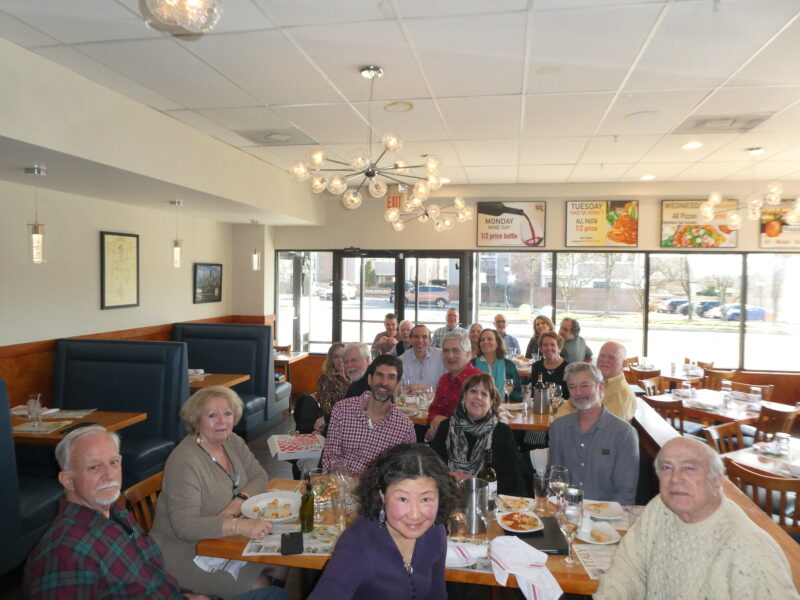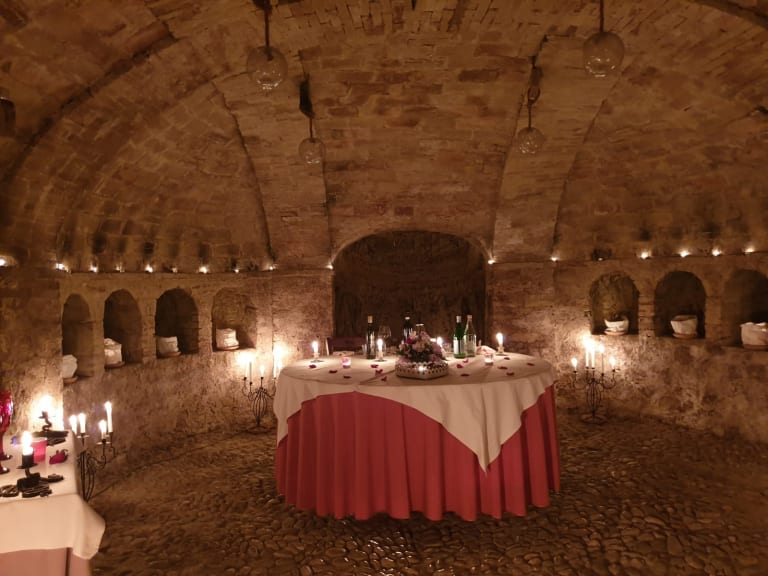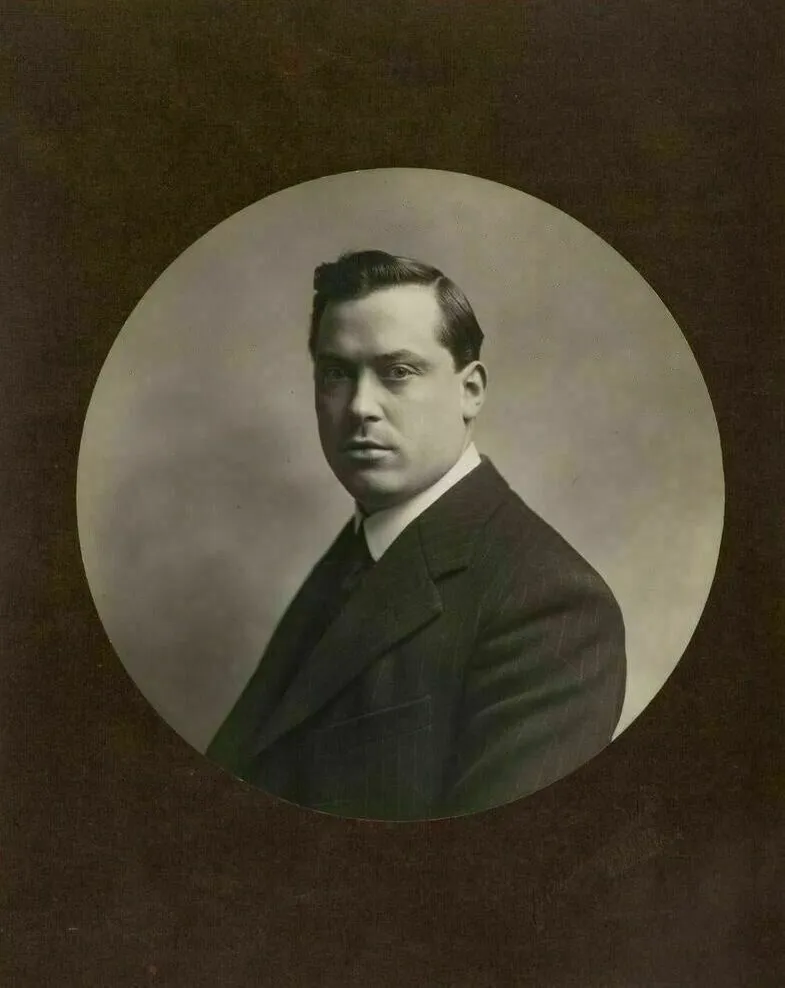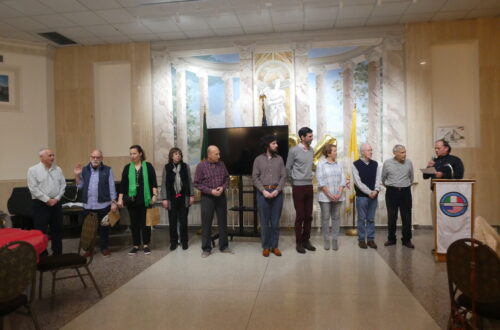-
Siamo Una Famiglia & Membership


AMHS President Chris Renneker (center) enjoyed Italian Heritage Night at the Washington Wizards on January 25 at the Capital One Arena in downtown Washington, D.C. Chris and friends Ravi Ganesh (left) and Jason Sabatelle had dinner at Matchbox before the game.
Credit: Ravi Ganesh
About 10 AMHS members and friends met for happy hour at Grazie Mille for some really good cocktails and appetizers, plus friendship and laughs. Pictured are AMHS members (starting second from left) Melis Mull, Board Member Mark Lino and Sarah Scott, along with friends Anastasia (far left) and Tiffany (right).
Credit: Maria D’Andrea-Yothers
Some 20 AMHS members, family and friends gathered at A Modo Mio in Arlington on February 25 for a group lunch. Conversation and fellowship flowed freely as everyone enjoyed the restaurant’s excellent food.
Credit: Courtesy of Maria D’Andrea-YothersAMHS Membership
We welcome new members: David Andrew DeAngelis, James Howard Rafferty, Johann Vento, Tonia Johnston, and Emilia Johnston.
Birthdays Compleanni a Marzo
Eileen Parise Del Monaco, March 1; Greg Bernabei, March 2; Maria Fresco, March 3; Stephen D’Alessio, March 5; Salvatore DiPilla, March 8; Charles Philip D’Adamo, March 9; Sam Yothers, March 12; Mary Petrino, March 14; Joanne Balzano, March 16; David Scalzitti, March 19; Diana Hoopes, March 23; Benjamin O’Hara, March 24; Mary Katherine Theis, March 25; Lucio D’Andrea, March 28; Macarena Clark, March 29; and Anna Maria DiPilla, March 31.Compleanni ad Aprile
Melis Mull, April 3; Joseph Theis, April 4; Susan Ann Bonsiero, April 5; Diana Bernabei, April 6; James Cocco, April 11; Bob Farrace, April 13; Teresa Talierco Scafetta, April 15; Alex Sawatzki, April 19; Dominic Balzano, Stephen Ulissi and Elena Francini-McGrann, April 21; Julia Conti, April 22; Berardino Palazzo, April 24; Belinda Sabatini, April 25; Christopher Renneker, April 26; Joann Novello, April 28; Tommaso Profenno, April 30.Anniversaries Anniversari a Marzo
Raymond & Barbara Bernero, March 26.Anniversari ad Aprile
Anthony & Norma Phillips, April 14; Michael & Elizabeth Iademarco, April 20; and Roberto & Bess DiTullio, April 25.Membership Information Category # of Persons
Associate (Couple) 2 X 2 = 4
Associate (Individual) = 35
General (Couple) 41 X 2 = 82
General (Individual) = 71
Honorary = 8
Scholarship = 2
Student = 6
Total = 208March 2024
-
Canzano

By Nancy DeSanti

Visitors can enjoy a candlelit dinner below ground in Canzano’s neviera (ice house).
Credit: eurcamping.itProvince of Teramo, Region of Abruzzo
The beautiful small town of Canzano in the province of Teramo has approximately 1,861 inhabitants, known as Canzanesi. It is renowned as one of the centers of traditional Abruzzese cuisine.
Canzano is located on a group of hills in the northern Vomano valley in a strategic position which explains the importance of this nowadays small center.
Historians have determined that the territory was inhabited in prehistoric times, and neolithic arrows have been found in the vicinity. During the Iron Age, it was settled by the ancient Italic tribe of Praetutii and later by the Romans.
The town of Canzano is located on a hill from which one can admire a striking view of the valley below and the chain of the Gran Sasso mountains. The built-up area is made up of noble palaces, 16th century houses, valuable churches, and still very visible remains of the ancient city walls, from which a well-preserved tower stands out. Very striking is a dense network of caves that are true and proper “cold rooms” once used to collect rainwater and to conserve foodstuffs.
On the Colle Castellano, there stands the splendid baroque church of the Madonna dell’Alno where, according to legend, the Virgin Mary appeared three times to a peasant. On the place of the first apparition, there stands the small church of the “Forgiveness.” In the Romanesque church of San Salvatore, beautiful frescoes from the 14th century are preserved.
Canzano is famous for its handmade production of lace and embroidery– traditions handed down by the women of the town with passion and patience.
The town is probably most famous for a traditional recipe passed from generation to generation–the famous “Canzanese turkey” (tacchino alla canzanese). This delicious jelly dish, served with a side of pickles, was almost a casual discovery. The local people realized that turkey broth prepared in the morning became gelatinous towards evening, thus incredibly enhancing the flavor of the meat. The recipe strictly requires the female turkey because its tender meat is more suitable for oven cooking.Consolidated over time, the ancient recipe is the undisputed favorite of the restaurant La Tacchinella. With now four generations in command, family owners have been running it since 1970.
But it is eight meters (26.25 feet) below the restaurant where an ancient wonder dating back to about the year 1100 A.D. can be found — the so-called neviera (ice house). The ice house is an old structure for natural refrigeration, by which meat was once stored using snow. After pressing the snow into straw, which insulated the snow, the result of a combination of snow and straw was then placed inside niches to lower the temperature and to obtain a true and proper cold room. While the air continued to circulate, the temperature was able to go down to zero degrees in winter. When spring arrived, the melted snow was then filtered and held aside as clean water for domestic use, without any waste.
This thousand-year-old invention was brought to Canzano by the Saracens, as portrayed in the emblem of the town, and it represents a living testimony of ancient technology. Today, besides being a wine cellar, the ice house is an enchanted place where visitors can enjoy an exclusive candlelit dinner, eight meters under the ground and a thousand years back in time.What to See
- Remains of the medieval walls with a majestic circular tower.
- Church of Madonna dell’Alno, from the 16th century, with Renaissance and Baroque paintings.
- Church of San Salvatore, outside the walls, with a stone portal and 14th-century frescos, including one depicting St. Louis of France, the Crusaders’ patron.
- Sancti Petri ad Palustrium, a small 12th-century church.
Important Dates
- February 3 – Feast of San Biagio, the patron saint of the town.
- May 18-20 – Celebration of Madonna dell’Alno.
- July 26 – Celebration of Sant’Anna, patron saint of women giving birth.
- First week in August – Exhibition of ancient and contemporary lacework, and Sagra of the Canzanese Tacchino.
- August – Exhibition of antique agricultural machines.
- August – Rendezvous of classical and antique motorcycles.
Italiano

Tradotto da Ennio Di Tullio
Provincia di Teramo, Regione Abruzzo
La bellissima cittadina di Canzano nella provincia di Teramo ha circa 1.861 abitanti, detti Canzanesi. È rinomato come uno dei centri della cucina tradizionale abruzzese.
Canzano è situato su un gruppo di colline nel nord valle del Vomano in una posizione strategica che spiega l’importanza di questo piccolo centro oggi.
Gli storici hanno stabilito che il territorio era abitato in epoca preistorica e nelle vicinanze sono state rinvenute frecce neolitiche. Durante l’età del ferro, fu colonizzato dall’antica tribù italica dei Praetutii e successivamente dai Romani.
Il comune di Canzano è situato su un colle dal quale si può ammirare un suggestivo panorama sulla valle sottostante e sulla catena del Gran Sasso montagne. L’abitato è costituito da palazzi nobiliari, case cinquecentesche, chiese di pregio, e resti ancora ben visibili dell’antica cinta muraria, da cui svetta una torre ben conservata. Molto suggestiva è la fitta rete di grotte che sono vere e proprie “celle frigorifere” un tempo utilizzate per raccogliere l’acqua piovana e conservare le derrate alimentari.
Sul Colle Castellano ci sorge la splendida chiesa barocca della Madonna dell’Alno dove, secondo la leggenda, la Vergine Maria apparve tre volte ad un contadino. Sul luogo della prima apparizione, ci sorge la piccola chiesa del “Perdono”. Nella chiesa romanica di San Salvatore, ci sono conservati bellissimi affreschi del XIV secolo.
Canzano è famosa per la produzione artigianale di pizzi e ricami, tradizioni tramandate dalle donne del paese con passione e pazienza.
La comune è probabilmente famosa soprattutto per una ricetta tradizionale tramandata da generazione a generazione: il famoso “tacchino alla canzanese” (canzanese turkey). Questa deliziosa gelatina, servita con un contorno di sottaceti, è stata quasi una scoperta casuale. La gente del posto si accorse che il brodo di tacchino preparato al mattino divenava gelatinoso verso la sera, così esaltava incredibilmente il sapore della carne. La ricetta richiede rigorosamente la femmina di tacchino perché la sua carne tenera è più adatta alla cottura al forno. Consolidata nel tempo, l’antica ricetta è la preferita indiscussa del ristorante La Tacchinella. Con ormai quattro generazioni al comando, la famiglia proprietaria lo gestisce dal 1970.
Ma è otto metri (26.25 piedi) sotto il ristorante che si nasconde un’antica meraviglia risalente al 1100 D.C.: la cosiddetta neviera (ghiacciaia). La ghiacciaia è una antica struttura per refrigerazione naturale, dove un tempo la carne veniva conservata utilizzando la neve. Dopo averlo pressato la neve nella paglia, che isolava la neve, la risulta di una combinazione di neve e paglia veniva poi riposto all’interno di nicchie per abbassare la temperatura e ottenere una vera e propria cella frigorifera. Mentre l’aria continuava a circolare, la temperatura poteva scendere fino a zero gradi in inverno. Quando la primavera arrivava, la neve sciolta veniva poi filtrata e tenuta da parte como aqua polita per l’uso domestico, senza alcuno spreco.
Questa invenzione millenaria fu portata a Canzano dai Saraceni, come raffigurato nello stemma del comune, e rappresenta una testimonianza vivente di antica tecnologia. Oggi, oltre ad essere una cantina, la ghiacciaia è un luogo incantato dove i visitatori possono godersi un’esclusiva cena a lume di candela, otto metri sotto la terra e mille anni indietro nel tempo.
Attrazioni del luogo:
- Resti delle mura medievali con una maestosa torre circolare.
- Chiesa della Madonna dell’Alno, del XVI secolo, con dipinti rinascimentali e barocchi.
- Chiesa di San Salvatore, fuori le mura, con portale in pietra e affresci del XIV secolo, tra cui uno raffigurante S. Luigi di Francia, mecenate dei crociati.
- Sancti Petri ad Palustrium, piccola chiesa del XII secolo.
Date da ricordare:
- 3 febbraio – Festa di San Biagio, il patrono del comune.
- 18-20 maggio – Festa della Madonna dell’Alno.
- 26 luglio – Festa di Sant’Anna, patrona delle partorienti.
- Prima settimana di agosto – Mostra di merletti antichi e contemporanei e Sagra della Tacchino Canzanese.
- Agosto – Mostra mercato di macchine agricole antice.
- Agosto – Appuntamento di motociclette classiche e antice.
July 2024
-
A Gem of a Wine from Abruzzo
AMHS Secretary Joseph “Sonny” Scafetta, Jr. obtained permission to reprint this article from the publication Fra Noi. Sonny has three cousins in Abruzzo who grow the grapes mentioned in the article.

March 2024
-
Nazzareno De Angelis: International Opera Star of the First Third of the 20th Century
By Joseph “Sonny” Scafetta, Jr.

Nazzareno De Angelis (Credit: Columbia Records CD) Accomplished opera singer Nazzareno De Angelis was born on November 17, 1881, in the city of L’Aquila (population 70,967 in the 2013 Census) which is the capital of the province with the same name in the region of Abruzzo. His first serious exposure to music came in local choirs as a boy soprano. Earning praise for the excellence of his voice, he became a part of the choir of the Giulia Chapel and later the Sistine Chapel in the Vatican. He left the Vatican at the age of 13 to begin studying with Dr. Faberi at the Accademia di Santa Cecilia in Rome. For several years, he studied both baritone and bass parts. Eventually, he settled on singing in the lower bass. He spent his last two years at the Accademia developing his repertoire and performing in recitals.
He returned home to L’Aquila at the age of 21 and made his professional opera debut there at the Comunale in May, 1903, in Donizetti’s Linda di Chamounix as the Prefect. One month later, he performed at the same theater in another opera, Le Educante di Sorrento, by Emilio Usiglio. Impressed by his performances, the manager of the Teatro Quirino in Rome engaged De Angelis to play Oroveso in Bellini’s Norma in July, 1903. Later that year, he appeared in two productions in the Teatro Adriano: first, as Il Spettro (The Ghost) in Ambroise Thomas’s Hamlet and then as Sparafucile in Verdi’s Rigoletto.
During 1905, De Angelis toured the Netherlands. After the tour, he was invited to all the major opera houses in Italy. He made his debut at La Scala in 1907 and appeared often under the baton of its principal conductor, Arturo Toscanini. He cut his first audio discs in 1907 and 1908 for Fonotipia Records. In 1909, he sang at the Paris Opera as the High Priest in Spontini’s La Vestale. During 1910 and 1911, he sang for the Chicago Grand Opera. For the season of 1911-1912, he sang a series of acclaimed roles at the Teatro Colón in Buenos Aires. In 1913, he returned to La Scala to sing the role of Archibaldo in Montemezzi’s L’amore dei Tre Re (The Love of the Three Kings). When Italy entered World War I in May, 1915, the draft eligible 33-year-old bachelor De Angelis moved to the Chicago Opera Association and stayed there until 1920. He then returned to Italy and made a sequence of tours throughout Europe. In 1931, he recorded Boito’s Mefistofele in Milan for the Italian label of Columbia Records. It is the only role that he recorded in its entirety. He retired from the opera stage in 1939 at age 58 and thereafter provided voice lessons to pupils in Milan and Rome, where he died on December 14, 1962, at age 81.
During his 36-year career, De Angelis appeared on stage more than 1,500 times, performing roles in 57 different operas. He was especially celebrated for his powerful portrayal of the title role in Mefistofele which he sang about 500 times between 1906 and 1938. He was also admired for his portrayals of Creon in Cherubini’s Medea and Moses in Mosè in Egitto. Selections from his recorded output, consisting mainly of arias and duets by Verdi, Rossini, Boito, Wagner, Puccini, Meyerbeer, Halévy, Thomas, Gounod, and Weber, have been issued by Preiser Records on two separate CDs, i.e. #89042 and #89507. His complete Mefistofele was re-issued on CD by Naxos Records in 2003 as #8.110273-74.Sources, both accessed March 14, 2021:
https://en.wikipedia.org/wiki/Nazzareno_De_Angelis
https://en.wikipedia.org/wiki/L’Aquila
March 2024
-
AMHS SCHOLARSHIP WINNERS: WHERE ARE THEY NOW?
Julia Paola is in Italy!

Julia Paola on vacation in Sardegna. By Maria D’Andrea-Yothers
Julia Paola, winner of the AMHS Scholarship in 2019 and currently a director on the AMHS board, departed for Torino in 2022 to obtain her Italian citizenship, which she did, in 2023. In November 2023, she passed an Italian fluency exam with a C1 “Advanced/Native” level fluency. She is currently studying at the Università degli Studi di Torino, pursuing a master’s degree in Area and Global Studies for International Cooperation, which she hopes to complete in 2025.
As an AMHS scholarship winner, Julia became an honorary Society member and served as an intern. She has remained involved with the Society and supporting events while living in Italy. Julia is originally from Annapolis and graduated in the Spring of 2022 from the George Washington University with a bachelor’s degree in International Affairs and Political Science with a concentration in International Politics for Europe and Eurasia. She also had a minor in Italian Literature and Language and served as the president of GWU’s Societa‘ di Cultura Italiana from May 2020 until she graduated. Her paternal grandparents are Piemontesi and Calabresi. She has been fortunate to visit her family in Torino and study abroad in Siena. During the 2020-2021 school year, she worked as a teaching aid for Italian virtually at her former high school.
After earning her master’s degree, Julia hopes to remain in Italy or Europe to work with refugees, teach Italian or English, or help others with Italian heritage to pursue their own Italian citizenship. She also hopes to write a guide for how to obtain one’s citizenship by applying directly in Italy as it was an invaluable experience for her and unlocked many potential opportunities.
Auguri Julia!
March 2024









